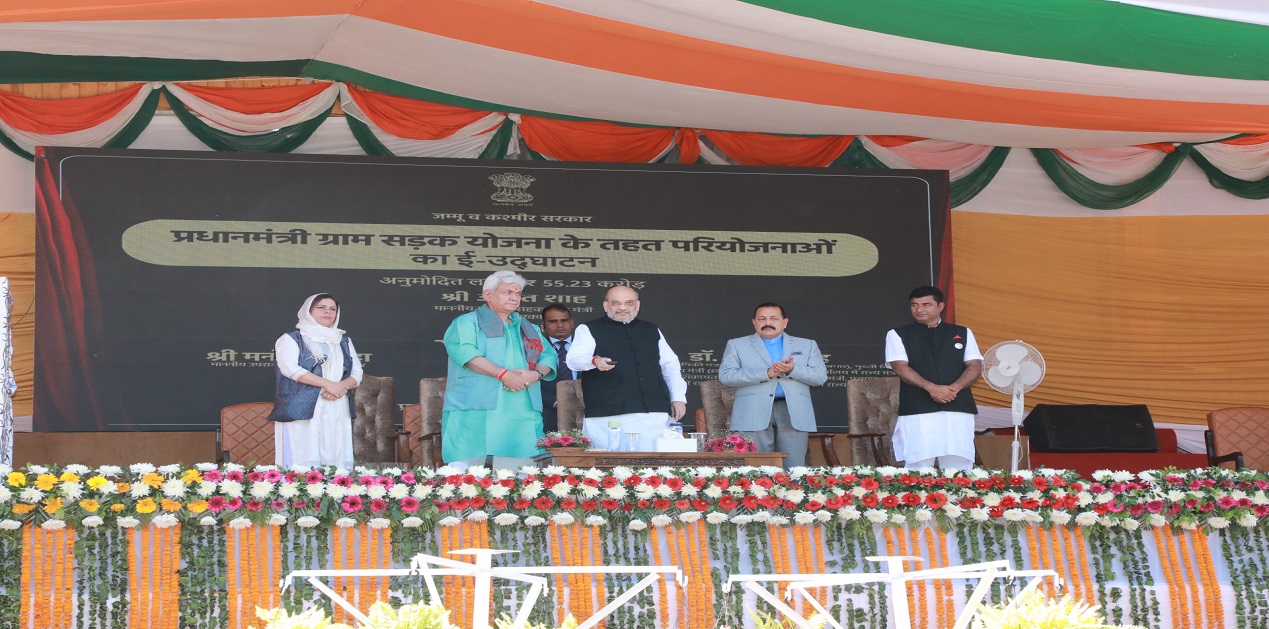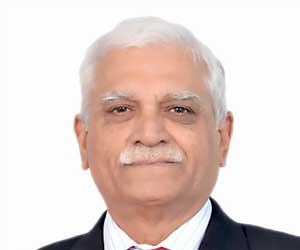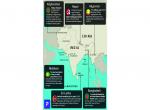Setting the Panorama
While India was in her biggest ‘festival mood’, the Home Minister was in the Union Territory of Jammu and Kashmir on a two-day visit to Rajouri and Baramulla. Since the announcement for this visit on 4th and 5th October 22 was made much in advance panorama scan’ of the region leading to the visit would be interesting. In this article we will use three channels to draw the panorama. First the media reports preceding and during the visit, secondly, an academic discourse in a conclave comprising of intellectuals from different fields in the valley-university and college students and thirdly a visual imagery of a common man who happened to be in the valley from 30 September to 4 October 22.
This wide- angle scan and its analysis will help us to identify whether the changes that we see in the region are good or otherwise for the people and secondly the strategic approach the local and central leadership need to take to propel the region to its rightful place in ‘Bharat that is India’.
Through the Eyes of the Media Reports
The Tribune on 01 October reported two Jaish Terrorists killed in a security forces operation near Baramulla [1]. These terrorists had planned to disrupt an army recruitment rally under the Agniveer scheme. In-fact the operation was launched on 29 September 22 it self. Besides major arms and ammunition was recovered in the Bandipore region (seven AK 74U rifles, hand grenades etc). On 03 October 22 a J&K Police personnel was killed by militants in Pulwama when they fired on a joint team of para military and local police, a terrorist was killed in Shopian while two bomb blasts were reported in Udhampur [2]. The DGP jail – Hemant Lohia, was killed at Jammu in his friend’s house presumably by his own help on 04 October 22 - People Anti-Fascist Group (PAAF) claimed responsibility for the killing [3]. Though in a newspaper account the police was reported as saying that there is no terror angle to this killing. [4] On 05 October 22 as the Home Minister was conducting his final meeting with security forces leaders and the LG, three militants of Jaish -e-Muhammed and one of Lashkar-e-Taiba were killed in two separate incidents. The Jaish militants killed in these encounters were involved in killing of the police personnel at Pulwama [5].
Average consumers of news from the mainstream media are likely to perceive a gloomy picture of the Union Territory. Their opinions and deductions on the matter concerning the region will trigger most of the drawing room discussions on the Kashmir related issues in India and abroad.
‘Conclave 2022’ [6]
On 01 October 22, a local media house organized a conclave for an academic discourse on some of the relevant issues in the Union Territory. The people in the conclave included vice chancellors, senior professors, entrepreneurs, social workers, cyber security and national security experts, journalists and most importantly young university students from Kashmir University, Cluster University including a college in Patan. Around a couple of hundred young, middle aged and some old well-educated people participated. The topics included in the conclave were interesting- The Kashmir Youth Choices, chances and challenges, economic investment and development, being a woman, era of social media and responsibility of Big Tech.
Three major aspects in this conclave are germane to our discussion. First was the non-verbal impression-behaviour, enthusiasm in participation and general conduct. Second aspect was the type of questions that were asked and the way the panelists answered these. Lastly was the frankness with which the issues were addressed by the panelists. To start with the Kashmiri youth that attended were enthusiastic, keen to listen and ask questions. Most girls were dressed in their traditional dresses while quite a few did choose informal dresses. There was no sign of traditional dresses among the women panelists.
During the first session on the future of Kashmiri youth one of the Vice Chancellors on the panel lamented the fact that from twenty to thirty thousand students from outside Jammu and Kashmir coming to the universities in the valley the number has dwindled down to two to three thousand. He was perhaps aware that students go to study in regions that is populated with open and liberal societies, societies that do not allow genocides to happen in their neighborhood. A young boy asked a very pointed question from the panelists “who is responsible for the current state?” It was quite evident that the educated youth in the valley thought that they deserved better and there has to be someone responsible for the current mess that they found themselves in. For obvious reasons the distinguished panelist decided to be more condescending than being frank. After all the valley was governed by their own with complete constitutional freedom that was not available to rest of the Indian states. In any case the young boy had made his point. The question signalled a deep yearning for change from the long shadow of the past.
During the discussion on economic development a student asked a politically loaded question on the after effects of abrogation of Article 370. What he probably implied was ‘has it helped in economic development’. Again, the panelists hesitated. A senior professor in the audience volunteered to answer and explained that it is too early to answer this with the support of authentic data. Again, fear of speaking the truth remained dominant. The universal truth is that number terrorist activities are inversely proportional to economic growth. Also, Article 370 was not only about economic development. In the same session when one of the panelists (an apple grower) listed out a large number of negatives that harm the apple growers and how the Iranians, Turkish apple growers are benefiting from the Indian markets at the cost of Kashmiri growers, the audience suggested that he needs to develop positive approach and learn to compete in a free market economy!
A young girl asked about gender equality when she found three of the four panels for the discussions were ‘all male’. She had a point. The panel discussion on ‘being woman’ where all the panelists were women who had distinguished themselves in their chosen fields – took that question. While emphasizing that women are created to be ‘more equal’ than their counter parts the societal systems and taboos that come naturally with closed communities make women second rate citizens in comparison to men. The panelists in the discussion were brutally frank replete with their personal examples of immense sufferings and humiliation, very candid about the righteousness of the stand they took and fearless in stating that they are masters of their own choices for right to work, choices for what to wear and claims of equality. As the women panelists spoke on subjects like domestic violence, divorce on account of exercising the right to work and gender bias they suffered even as small girls the young students listened with complete attention. No questions asked; no contradictions by the students as well as the elderly audience. This by far was the best session of the conclave in its originality, spontaneity and truthfulness. It also brought the innate desire to break free of the shackles of unfair practices.
Srinagar and Around: The Visual Panorama 2nd to 4th October 22
Oblivion to the violent activities reported in the media the Sheikh Ul Alam International Airport Srinagar was bursting with tourists on 30th September as also on 4th October 22. Traffic on the swanky flyovers from the airport to the city as also in the famous Lal Chowk area was heavy and well regulated [7], [8]. The bill boards on the shopping arcades and busy bazaars depicted all types of companies and activities as one would see in any of the Indian metro cities.
The famous United Nation office in Srinagar (United Nations Military Observer Group in India and Pakistan – UNMOGIP) was used only as a landmark to guide a friend to the Coffee Café Day restaurant close by on the opposite side of the road where UNMOGIP was located.
The Dal Lake was host to thousands of tourists. People were climbing up the nearby hill to seek blessing of Lord Shiva in the Shankaracharya temple. Hordes of tourists roamed around freely with tilaks on their fore heads. On 3rd October 22 around 100 odd Kashmiri youth were waiting inside the military campus for recruitment into Army through the Agniveer plan. More than double this number were queued up at the entry gate for their turn.
Early morning activities in the suburbs of Srinagar towards Ganderbal and Kheer Bhawani temple depicted normalcy and calm amidst the surveillance grids and unobtrusive armed guards at various places- perhaps part of the surveillance system. Closer to Ganderbal in a picturesque river bank the young boy driving our taxi showed around the areas where some of the famous Hindi films were shot. The excitement in his narrative was quite evident. The Kheer Bhawani shrine had a couple of pujaris and around twenty odd devotees at noon. For a famous and historic shrine like this the number was surprisingly small. It is quite likely that pre 1990 era would have witnessed much larger number of devotees seeking blessings from their deity.
On 4th October 22 prominent routes that were to be used by the Home Minister for his visit were adorned with huge display board showing him with pleasant smile. The venues around were all being spruced up. A casual visitor would not have seen any sullen faces, no shut downs and no anger whatsoever.
If the Narrative Has Already Changed- What is the Envisioned Future?
Answer to the first question needs to be based on numbers. A comparison of period from 2001 to 2004 with more recent four years- 2019 to 2022 would bring out realistic assessment. We compare the data on terrorist activities as shown in the South Asian Terrorism Portal (SATP) [9]
Table 1 : Terrorist Activities Jammu and Kashmir

Table 2. How Did the GSDP per Capita Move [10]

Note. In 2018-19 J&K was in the third group of Indian states with GSDP per capita between INR 100,000 to 200,00. While Punjab, Haryana and Himachal Pradesh were in the second group with GSDP per capita more than INR 200,000/-[11] with the current trend J&K may catch up soon.
The numbers in both the tables promise a bright future for the region. However, numbers never tell the complete story. There are a few factors that would provide the necessary force to keep the acceleration on the surface that has adequate friction. The accelerating force comprises of the following:
- Pakistan as an external supporter for the nefarious activities in the valley has lost steam and staring at the prospects of becoming a basket state. The domestic politics in India have stopped considering Pakistan as a factor. (No Hurriyat, no special article in the constitution allowed local politicians to hob nob with Pakistan)
- Stable and proactive no nonsense government at the center.
- The youth and academicians appear to be introspecting and likely to support rational decisions.
- Booming economy in India post pandemic.
Hence going by the numbers as also factors providing the tailwind J&K is going to stay the course for prosperity sans terrorism and political road blocks. The frictional forces are likely to be more societal and pertaining to harmony of the social capital.
Conclusion
The media reports discussed in the beginning do indicate the simmering fires of terrorism do exist in penny packets and cannot be ignored. However, the feel that a casual but discerning observer in the region gets is different. That view would depict the initial stages of chain reaction for a transformative change for the better. This chain reaction will have to be sustained by a critical mass of human capital. In the Kashmir Central Conclave, the initial embers of the chain reaction could be felt. The Home Minister’s two days visit may create the critical mass for sustaining the change for the better.
End Notes
[1]Two Jaish Terrorists killed during Security Forces Operations near Baramulla, The Tribune 01 October 22.
[2] Terrorists kills J&K Cop injure CRPF man ahead of Shah’s visit The Times of India 03 October 22
[3]J&K Prison Chief Killed at his Friends Home, ‘The Telegraph’ 05 October 22
[4]Cops rule out terror angle nab ‘killer’ of DG Prison, ‘Times of India’ 05 October 22
[5]Amid J&K encounters Shah chairs key meet, 4 ultras killed 2 linked to SPO &migrants Death Times of India 06 October 22 ‘Times of India’ 06 October 22
[6]A local media organization based in Srinagar had organized ‘Kashmir Central 2022’ Conclave on 01 October 22 at Srinagar. The author was invited as an expert to this event.
[7]https://www.wionews.com/india-news/tourism-in-kashmir-breaks-all-records-as-340000-visitors-throng-valley-in-3-months-469412 08 April 22 (Accessed on 05 October 22)
[8]https://www.greaterkashmir.com/todays-paper/front-page/over-1-crore-tourists-visited-jk-in-last-6-months 19 July 22, Accessed on 05 October 22)
[9]https://www.satp.org/datasheet-terrorist-attack/major-incidents/india ( Accessed on 05 October 22)
[10]https://www.ceicdata.com/en/india/memo-items-state-economy-net-state-domestic-product-per-capita/nsdp-per-capita-jammu-and-kashmir( Accessed on 05 October 22)
[11]https://statisticstimes.com/economy/india/indian-states-gdp-per-capita.php( Accessed on 05 October 22)
(The paper is the author’s individual scholastic articulation. The author certifies that the article/paper is original in content, unpublished and it has not been submitted for publication/web upload elsewhere, and that the facts and figures quoted are duly referenced, as needed, and are believed to be correct). (The paper does not necessarily represent the organisational stance... More >>
Image Source: https://www.mha.gov.in/media/gallery











Post new comment